
LM-61M - evolution of Polish 60mm mortars

ZM Tarnów SA mortars and ammunition presented at the Pro Defense 2017 exhibition in Ostróda, on the left is an LM-60D mortar with a CM-60 sight, also offered to the Polish Army.
This year, at the International Defense Industry Exhibition, Zakłady Mechaniczne Tarnów SA, part of Polska Grupa Zbrojeniowa SA, is presenting the latest concept of the LM-60M modular 61mm mortar, adapted to fire ammunition produced in NATO member countries. The debut of the innovative modular LM-61M confirms the position of ZM Tarnów SA not only as the leading manufacturer of 60mm mortars in Poland, but also as the world leader in this market segment.
The experience of using 60-mm mortars LM-60D / K in the Ground Forces, including in war conditions (PMCs in Afghanistan and Iraq), confirmed the high combat value of these weapons, as well as the quality of workmanship. Also during allied exercises, including with US Army units armed with 60-mm M224 and LM-60D / K mortars, they proved that they are a world-class design with the highest parameters. It should also be emphasized that the LM-500D mortars, already delivered to the Polish Army in the amount of more than 60 units, as domestic weapons, are accredited by OiB (defense and security) - the Research Laboratory Group of the Military Institute of Weapons Technology. . Therefore, their tactical and technical characteristics are confirmed by external, objective tests required by law when purchasing Polish weapons for the Polish Armed Forces.
The value of 60 mm mortars
Polish conditions, including the specifics of the organization of artillery and the equipment used by it, mean that the most suitable, and in fact the only means of direct support for developing infantry with a range of over 500 meters, are mortars. The simplicity of the design of this flame retardant and its relatively low purchase price (of course, we do not mean the M120K Rak system - ed.) mean that the expected growth in demand for mortars in Europe alone is as much as 63%. . The lightest type of them in the Ground Forces is currently the 60mm LM-60D (long-range) and LM-60K (commando) mortars manufactured by ZM Tarnów SA, also for export. 60mm mortars are available at platoon and company levels. In this role, they previously supplemented, and now completely replaced the obsolete Soviet 82-mm mortars wz. 1937/41/43, judging by the markings, the buildings are about 80 years old. The arsenal of WP mortars today is complemented by modern 98 mm M-98 mortars, designed at the Research Center for Earth Machinery and Transport in Stalowa Wola and manufactured by Huta Stalowa Wola SA, and self-propelled 120 mm M120K Rak mortars. , also from HSW SA, the first examples of which were recently put into service (see WiT 8/2017), as well as 120 mm mortars wz. 1938 and 1943 and 2B11 Sani.
An important step of the current government and the leadership of the Ministry of National Defense was the decision to form the Territorial Defense Forces (for more details, see the interview with the Commander of the Territorial Defense Forces, Brigadier General Wiesław Kukula – WiT 5/2017). It is known that the IVS will include support platoons. So the question is, what weapon will they use? The fastest response is Polish light mortars produced in Tarnow. The reason is obvious - the 60mm mortar is a platoon or company-level artillery piece and as such is used both for attack and defense (it seems that the latter case will be the main essence of TCO operations).
In the attack, 60-mm mortars provide the units armed with them:
- immediate fire response to enemy support means;
- providing conditions for maneuver to stop the enemy counterattack;
- inflicting losses on the enemy, temporarily depriving him of combat capability;
- blocking or limiting the maneuver of enemy forces;
- combating enemy fire weapons that directly threaten their attacking subunits.
However, in defense it is:
- dispersal of advancing enemy forces;
- limiting the mobility of enemy forces;
- coercion to occupy territory within range of other weapons of friendly troops (for example, 5,56 and 7,62 mm machine guns, 40 mm grenade launchers, 5,56 mm automatic carbines, hand-held anti-tank grenade launchers) by shelling the territory immediately behind the enemy positions, which forces him to move into the zone of effective range of fire of the aforementioned protects his units;
- violation of the synchronization of enemy actions by combining fire with other fire weapons of friendly troops;
- combating fire weapons (machine guns, artillery) and command and control units of the advancing enemy.